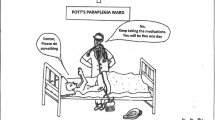Summary
Twenty-three patients with atypical forms of spinal tuberculosis treated between 1975 and 1985, are described.
All presented with signs and symptoms of compression of the spinal cord or cauda equina, ranging from paraesthesiae and increasing weakness of extremities to paraplegia and loss of sphincter control. None of them showed visible or palpable spinal deformity nor the typical radiographic appearance of destruction of the intervertebral disc and the two adjoining vertebral bodies. These atypical forms constituted about 12 percent of all the cases of spinal tuberculosis seen (a total of 190 cases); and fell into three well-defined groups: those with the involvement of neural arch only; those with the inolvement of a single vertebral body; and, those without bony involvement. The correct surgical approach in these groups was found to be different: spinal cord compression caused by the tuberculous disease of the neural arch was best treated by laminectomy; whereas single vertebral body disease required an anterior or anterolateral approach. Spinal computerized tomography was helpful in defining the extent of disease and planning the surgical approach. Histological confirmation of tuberculosis was obtained in all the cases and acid fast bacilli (A.F.B.) were found in, and cultured from, the biopsy specimens of 18 cases.
Similar content being viewed by others
References
Naim-Ur-Rahman (1980) Atypical forms of spinal tuberculosis. J Bone Joint Surg [Br] 62 B: 162–165
Kulowski J (1936) Pyogenic osteomyelitis of the spine. An analysis and discussion of 102 cases. J Bone Joint Surg 18: 343–364
Blacklock JWS (1957) Injury as an etiological factor in tuberculosis. Proc R Soc Med 50: 61–68
Hodgson AR (1975) The Spine. Rothman RH and Simeone FA (eds) Vol 11, Chapter 12, pp 567–595. WB Saunders Company
Batson OV (1940) The function of the vertebral veins and their role in the spread of metastases. Ann Surg 112: 138–149
Batson OV (1957) The vertebral vein system. Caldwell Lecture, 1956. AJR 78: 195–212
Henriques CQ (1958) Osteomyelitis as a complication of urology. Br J Surg 46: 19–28
Clemens HJ (1961) Die Venensysteme der menschlichen Wirbelsäule. De Gruyter, Berlin
Herlihy WF (1947) Revision of the venous system, the role of vertebral veins. Med J Aust I: 661–672
Herlihy WF (1948) Experimental studies in the internal vertebral venous plexus. Essays in Biology 151
Anderson JE (1978) In: Grant's atlas of anatomy, seventh edition. Williams & Wilkins, Baltimore
Black P (1979) Spinal Metastasis: current status and recommended guidelines for management. Neurosurgery 5: 726–745
Author information
Authors and Affiliations
Rights and permissions
About this article
Cite this article
Naim-Ur-Rahman, Al-Arabi, K.M. & Khan, F.A. Atypical forms of spinal tuberculosis. Acta neurochir 88, 26–33 (1987). https://doi.org/10.1007/BF01400511
Issue Date:
DOI: https://doi.org/10.1007/BF01400511




